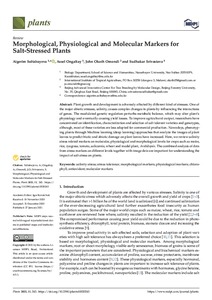| dc.contributor.author | Soltabayeva, A. |
| dc.contributor.author | Ongaltay, A. |
| dc.contributor.author | Omondi, J.O. |
| dc.contributor.author | Srivastava, S. |
| dc.date.accessioned | 2021-07-01T10:07:41Z |
| dc.date.available | 2021-07-01T10:07:41Z |
| dc.date.issued | 2021 |
| dc.identifier.citation | Soltabayeva, A., Ongaltay, A., Omondi, J.O. & Srivastava, S. (2021). Morphological, physiological and molecular markers for salt-stressed plants. Plants, 10(2), 243: 1-18. |
| dc.identifier.issn | 2223-7747 |
| dc.identifier.uri | https://hdl.handle.net/20.500.12478/7152 |
| dc.description.abstract | Plant growth and development is adversely affected by different kind of stresses. One of the major abiotic stresses, salinity, causes complex changes in plants by influencing the interactions of genes. The modulated genetic regulation perturbs metabolic balance, which may alter plant’s physiology and eventually causing yield losses. To improve agricultural output, researchers have concentrated on identification, characterization and selection of salt tolerant varieties and genotypes, although, most of these varieties are less adopted for commercial production. Nowadays, phenotyping plants through Machine learning (deep learning) approaches that analyze the images of plant leaves to predict biotic and abiotic damage on plant leaves have increased. Here, we review salinity stress related markers on molecular, physiological and morphological levels for crops such as maize, rice, ryegrass, tomato, salicornia, wheat and model plant, Arabidopsis. The combined analysis of data from stress markers on different levels together with image data are important for understanding the impact of salt stress on plants. |
| dc.description.sponsorship | Nazarbayev University |
| dc.format.extent | 1-18 |
| dc.language.iso | en |
| dc.subject | Stress |
| dc.subject | Salinity |
| dc.subject | Tolerance |
| dc.subject | Morphology |
| dc.subject | Marker-Assisted Selection |
| dc.subject | Chlorophylls |
| dc.subject | Antioxidants |
| dc.subject | Molecular Markers |
| dc.title | Morphological, physiological and molecular markers for salt-stressed plants |
| dc.type | Journal Article |
| cg.contributor.affiliation | Nazarbayev University |
| cg.contributor.affiliation | International Institute of Tropical Agriculture |
| cg.contributor.affiliation | Beijing Forestry University |
| cg.coverage.region | Africa |
| cg.coverage.region | Southern Africa |
| cg.coverage.hub | Eastern Africa Hub |
| cg.identifier.bibtexciteid | SOLTABAYEVA:2021 |
| cg.isijournal | ISI Journal |
| cg.authorship.types | CGIAR and developing country institute |
| cg.iitasubject | Agronomy |
| cg.iitasubject | Crop Systems |
| cg.iitasubject | Maize |
| cg.iitasubject | Plant Breeding |
| cg.iitasubject | Plant Diseases |
| cg.iitasubject | Plant Health |
| cg.iitasubject | Plant Production |
| cg.journal | Plants |
| cg.notes | Open Access Journal; Published online: 27 Jan 2021 |
| cg.accessibilitystatus | Open Access |
| cg.reviewstatus | Peer Review |
| cg.usagerightslicense | Creative Commons Attribution 4.0 (CC BY 0.0) |
| cg.targetaudience | Scientists |
| cg.identifier.doi | https://dx.doi.org/10.3390/plants10020243 |
| cg.futureupdate.required | No |
| cg.identifier.issue | 2: 243 |
| cg.identifier.volume | 10 |
| cg.contributor.acknowledgements | The authors would like to thank Adnan Yazici for support and consultations. We would like to thank Damira Kanayeva for help and support. |

